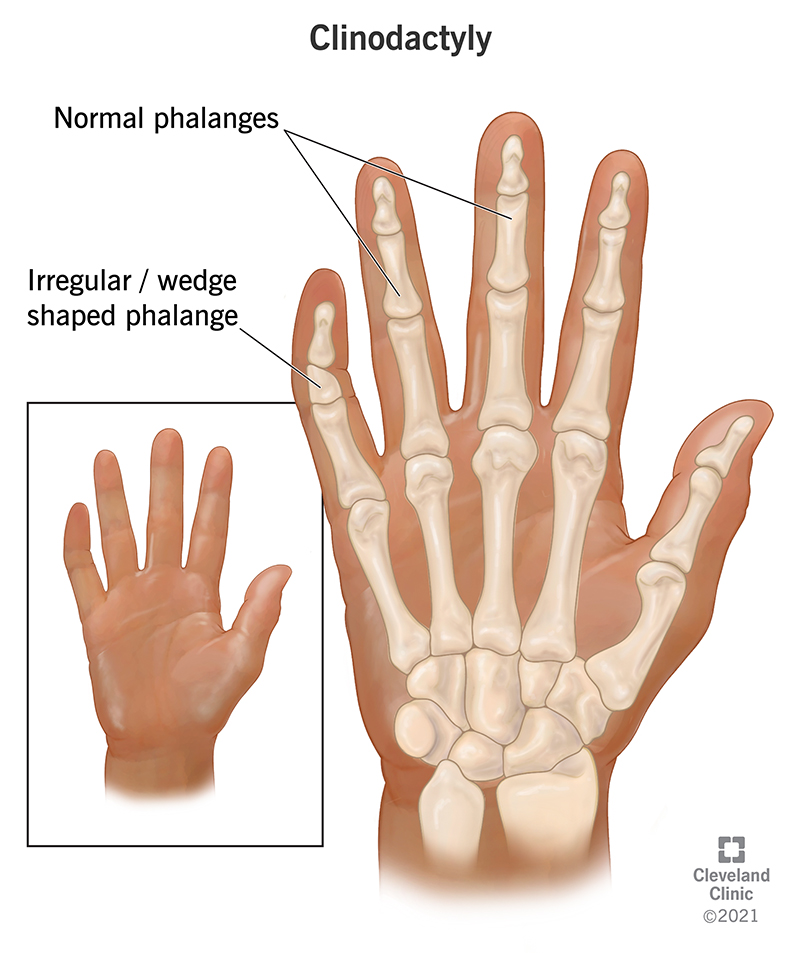Clinodactyly is a curve of your finger that resembles a hook. The curve is common and often affects your pinky finger. The condition is the result of your bone growing in an abnormal shape. Treatment isn’t necessary unless the curve prevents you from using your fingers.
Advertisement
Cleveland Clinic is a non-profit academic medical center. Advertising on our site helps support our mission. We do not endorse non-Cleveland Clinic products or services. Policy

Clinodactyly is a minor bone malformation where your finger curves at the joint closest to your nail and bends toward your other fingers like a hook. It most often affects your fifth digit (pinky finger), but it can happen to any finger or toe. The curve is the result of your finger bone growing in a different shape than it should. It may be present at birth or it may happen as a result of injury to a growing finger in childhood.
Advertisement
Cleveland Clinic is a non-profit academic medical center. Advertising on our site helps support our mission. We do not endorse non-Cleveland Clinic products or services. Policy
It’s normal for fingers to curve at an angle less than 10 degrees. Clinodactyly specifically refers to finger curves at angles greater than 10 degrees.
Clinodactyly can affect anyone. It’s more common among males.
When no other medical problems are present the condition is called isolated clinodactyly. It may also occur as part of a genetic syndrome, including Down syndrome, Turner syndrome and Klinefelter syndrome. About 1 in 4 people diagnosed with Down syndrome have clinodactyly.
The exact rate of occurrence is unknown, different studies have shown that 1% to 2% or as many as 20% of people may have clinodactyly.
Clinodactyly is generally harmless and only affects how your fingers look, not how well they work.
Symptoms of clinodactyly appear in a finger on your hand. The condition can be present at birth (congenital) even if symptoms aren’t noticeable until early childhood when the bones grow and start to mature. Clinodactyly could appear on one or both of your hands and on any one finger. The condition also affects toes. Symptoms of clinodactyly include:
Advertisement
Individuals with clinodactyly are still able to use their fingers normally. Although rare, if the curve in your finger is greater than a 30-degree angle, you’ll have a limited range of motion in the affected finger and you may need surgery to correct it.
An abnormally shaped bone in your finger causes clinodactyly.
There are usually three bones (phalanges) in your second (index or pointer), third (middle), fourth (ring) and fifth (pinky) digits. The bones stack on top of each other, forming two joints. Sometimes the bone in the middle of your finger, between your middle knuckle and the furthest knuckle from your wrist (distal), grows in the shape of a wedge (trapezoid or triangle) instead of growing in the shape of a rectangle. When the bone grows incorrectly, the bones can’t stack in a straight line, which gives your finger a curve at its end.
There are several factors that cause clinodactyly, including inheriting the trait.
Clinodactyly can occur because of an injury that happens to your finger when your bones are still growing. It can stunt the growth of your finger bone. Instead of growing in the normal rectangular shape, the bone grows into the shape of a wedge.
More common, clinodactyly isn’t related to an injury. It can occur randomly or you can inherit the trait from your parents. If one of your parents has the gene that causes clinodactyly, they pass that gene onto you in an autosomal dominant genetic pattern. This means that if you get that gene from a parent, you will also have clinodactyly. Sometimes clinodactyly is a symptom of a more complex genetic condition with additional symptoms present.
Several genetic conditions affect bone growth and cause clinodactyly as a symptom. These conditions include:
Your healthcare provider will diagnose clinodactyly after reviewing your medical history and physically examining your finger. They may take an X-ray of your hand to get a better look at the bones inside your finger and test your range of motion (flexibility test) to see how well you can move the joint in your finger.
Most of the time, no treatment is necessary for clinodactyly.
In severe cases, your healthcare provider might recommend reconstructive surgery if the curve in your finger is significant (curved at an angle greater than 30 degrees) and it’s stopping you from using your finger normally. Surgery is most effective among children with bones that are still growing.
Clinodactyly is a lifelong condition that usually only affects how your finger bone grows, not how your finger works. Treatment isn’t necessary unless the curve in your finger prevents you from using it.
You can’t prevent most cases of clinodactyly because it occurs randomly or is the result of your changes to your genes. If you have a syndrome that causes clinodactyly or if your parent also has clinodactyly, your provider or a genetic counselor can help you understand your risk of passing it onto your child.
Advertisement
Visit your healthcare provider if the curve in your finger prevents you from using it or if you lose range of motion in your bent finger.
Clinodactyly doesn’t cause pain, so if you experience pain or discomfort in your curved finger, contact your healthcare provider.
Clinodactyly is a harmless condition that shouldn’t cause pain or change the way you use your fingers. Unless the angle of your finger’s curve is greater than 30 degrees, your healthcare provider won’t recommend surgical treatment. The curve in your finger is part of who you are that makes you unique.
Advertisement
Last reviewed on 02/21/2022.
Learn more about the Health Library and our editorial process.